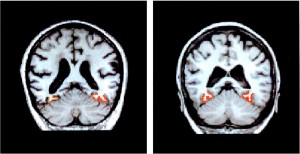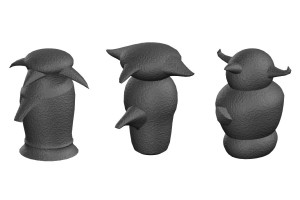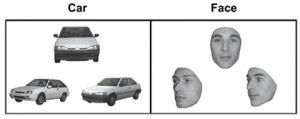History: The Establishment of the Fusiform Gyrus as Involved in Face Recognition
In 1992, a research team led by Dr. Justine Sergent published an article in Brain: Journal of Neurology, which presented the results of a Positron Emission Tomography (PET) study aimed at identifying the underlying neural structures involved in face and object processing. What Sergent et al. found would result in the generation of an entire new field within Cognitive Neuroscience.
Analysis of the PET data collected from the study revealed that a brain region called the Fusiform Gyrus was highly active during tasks that required face processing, but that the area was not active during object processing tasks. Sergent et al. concluded that the results offered, “new information about the dissociation between face and object processing” [1].
The attention of the Cognitive Neuroscience community had been captured. Yet, it would be five years later when the Fusiform Gyrus and its functional purpose would really become such a highly debated topic. In 1997, an fMRI study performed by Kanwisher et al. found the Fusiform Gyrus to be more active during face recognition tasks than in tasks requiring recognition of objects or other body parts. The experiment included multiple tests, all of which compared face recognition to recognition of a different category. Analysis of the data resulted in a consistent pattern of increased activity demonstrated by the Fusiform Gyrus during face recognition tasks. From their results, Kanwisher et al. concluded that the Fusiform Gyrus was “selectively involved in the perception of faces”, and renamed the Fusiform Gyrus as the Fusiform Face Area (FFA) [2].
The Expertise Hypothesis
Kanwisher et al.’s strong and confident claims about the relatively novel notion that “faces are special” resulted in a cascade of follow-up research on the FFA and its functional purpose. Though a large majority have found the FFA to be involved in face recognition, not all support the assertion that the brain region is “selectively involved in the perception of faces”. In fact, a large portion of the research conducted contends that the FFA is a region not simply specialized for face recognition, but rather that it more generally specializes in areas of expertise. The Expertise Hypothesis purports that the FFA can be invoked by any domain of expertise and explains that face recognition activates the FFA because people are experts at recognizing faces.
Controversy
In essence, there appears to be a division within the existing body of research regarding the assertion that “faces are special”. Equally valid and reliable research exists both in support and in negation of the notion. And so the controversy presents itself: “are faces special?”
“Faces are Special.”
Duchaine et al. (2004) would tend to support the notion that “faces are special” after conducting a study on prosopagnosic patient, Edward. Prosopagnosia is defined as a deficit in the ability to recognize familiar faces. However, other than the prosopagnosia, Edward had no other mental or physical impairments, and he scored within the normal range on both vision tests and object recognition tests. Duchaine et al. administered Greeble Training to Edward in order to test Edward’s abilities to acquire expertise. Greebles are novel figures that demonstrate distinct features that allow for distinguishability. There are sixty Greebles which can be categorized at the family, gender, and individual levels. Greeble Training results in acquiring a level of Greeble Expertise, in which one can consistently recognize the distinguishments and identify the Greeble [3]. Duchaine et al. found Edward to perform normally throughout standard Greeble Training procedure, indicating that face recognition and greeble recognition must rely on separate mechanisms [4]. Edward was able to acquire the level of Greeble Expertise, despite his severe impairments in recognizing faces, suggesting that “faces are special”, due to the fact that face recognition is a process that can be selectively impaired.
“Faces are not Special.”
Yet, McKeef et al. (2010) would tend to disagree with the notion that “faces are special”. In McKeeff et al.’s investigation regarding the effect of object expertise on face processing, car experts and car novices were administered a task which required participants to search for a target, a face or a watch, amongst distractors, which included faces and cars. Results demonstrated that car experts exhibited a higher response time than car novices when identifying faces amongst task irrelevant cars, but a lower response time than car novices when identifying watches amongst task irrelevant cars. McKeeff et al.’s findings suggest that object expertise results in greater functional overlap between the object of expertise and faces and less functional overlap between the object of expertise and other objects [5]. These findings also suggest that object expertise can interfere with face recognition. The conclusions drawn by McKeeff et al. negate the notion that “faces are special”, because face recognition does not appear to be an exclusive process; furthermore, the conclusions support the Expertise Hypothesis, as recognition of faces and objects of expertise appear to rely on a shared neural mechanism.
“So… Are Faces Special?”
Bilalic et al. (2011) conducted an fMRI study that compared FFA activity of chess experts and chess novices during a series of tasks that included face recognition and chess-related recognition. Chess experts did demonstrate higher levels of FFA activity than chess novices during chess-related tasks. However, in a task that required participants to passively view faces and chessboards, FFA activation was highest for both chess experts and chess novices, when face stimuli were presented [6]. The results of Bilalic et al.’s fMRI experiment indicate that while the FFA is probably a general expertise module specialized for individuation and differentiation, the assertion that “faces are special” can be supported due to the extraordinary amount of FFA activation associated with the presentation of face stimuli.
Ultimately, the question of whether or not “faces are special” cannot completely be answered with a direct “yes” or “no”; rather, the existing body of research presents the answer as lying somewhere in between the two. A precise answer may never be found, but only further Cognitive Neuroscience research will continue to expand the knowledge and understanding of face recognition and the FFA, providing the opportunity to move closer and closer to a resolution of the long-debated controversy: “are faces special?”
References
[1] Sergent, J., Ohta S., & MacDonald, B. 1992. Functional neuroanatomy of face and object processing. A positron emission tomography study. Brain, 1, 15-36.
[2] Kanwisher, N., McDermott, J., & Chun, M.M. (1997). The fusiform face area: A module in human extrastriate cortex specialized for face perception. The Journal of Neuroscience, 17(11), 4302-4311.
[3] Gauthier, I, & Tarr, M.J. (1997). Becoming a “greeble” expert: Exploring mechanisms for face recognition. Vision Research, 37(12), 1673-1682.
[4] Duchaine, B.C., Dingle, K., Butterworth, E., & Nakayama, K. (2004). Normal greeble learning in a severe case of developmental prosopagnosia. Neuron, 43(4), 469-473. doi: 10.1016/j.neuron.2004.08.006
[5] McKeeff, T.J., McGugin, R.W., Tong, F., & Gauthier, I. 2011. Expertise increases the functional overlap between face and object perception. Cognition, 117(3), 355-360. doi: 10.1016/j.cognition.2010.09.002
[6] Bilalić, M., Langner, R., Ulrich, R., & Grodd, W. 2011. Many faces of expertise: Fusiform face area in chess experts and novices. The Journal of Neuroscience, 31(28), 10206-10214. doi: 10.1523/JNEUROSCI.5727-10.2011



